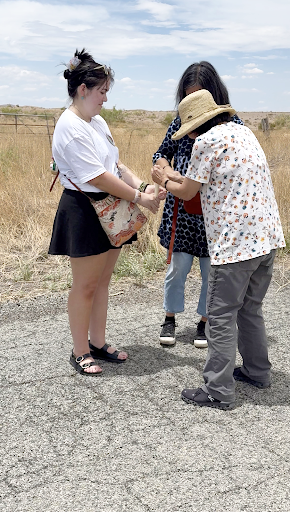
Katie Masano Hill
On July 27, 1942, Toshio Kobata and Hirota Isomura were murdered by a U.S. Army guard while being transferred to the Lordsburg Internment Camp in New Mexico. It has now been 83 years since that act of violence, a tragedy that poses a poignant reminder of what happens when fear is weaponized, and power goes unchecked.
One week before this painful anniversary, I had the honor of joining a pilgrimage to Lordsburg. The visit was led by Victor Yamada and Nikki Nojima-Louis of the New Mexico JACL chapter and Mollie Pressler of the Lordsburg Museum. I was joined by community members, including Julie Abo, who helped guide our incense ceremony at the site where Mr. Kobata and Mr. Isomura were killed.
Standing in the sunbaked desert, under the telephone pole that presents the only marker of the murders, we lit incense and offered prayers. As I was saying their names and reading a tanka poem written by a Lordsburg prisoner, the flame unexpectedly burned my finger.

(From left) Katie Masano Hill, Julie Abo and Sue Ann Kenmotsu-Butler offer gassho and incense in solemn remembrance of those lost at Lordsburg. (Photo: Courtesy of Katie Masano Hill)
At that moment, I felt the presence of Mr. Kobata and Mr. Isomura reaching through the silence and smoke. I also felt the presence of my Great-Uncle Yoshi, who never got to escape Tule Lake.
Mollie shared with us the tragic and dehumanizing details that followed their deaths; their bodies buried improperly, how one of the men was still alive after being shot and begging for his life.
The official story claimed that two elderly men, one with a spinal injury whose whole body would tremble while he walked and the other with damaged lungs from tuberculosis, somehow ran from armed soldiers: an impossible fabrication.
As we stood at the site where they were killed, I was struck by how close they had come to the prison camp entrance. That realization filled me with a deep, aching sorrow and confusion. Why murder two prisoners, why do it at all? Why harm these elders in this way? Why subject them to such inhumanity?
I also thought of my own great-uncle, Kahei Sam Morikawa, who was interned under the Alien Enemies Act at 61 years old and taken to Fort Missoula, Lordsburg, Santa Fe, Crystal City, Topaz and then Tule Lake. Standing on the land where he once stood, where he survived extreme conditions of hate and brutality, I could feel the weight of his resilience. You can read more about his story at https://jacl.org/kahei-sam-morikawa.
There are hard lessons buried in places like Lordsburg. Lessons about what this country has done and too often chooses to forget. But there is also strength in remembrance. By returning with care and intention, we resist the erasure. We honor the humanity of Mr. Kobata and Mr. Isomura. We say their names. And in doing so, we transform memory into a call for justice.
In this space, I reflect not only on Mr. Kobata and Mr. Isomura but also on others whose lives were lost behind barbed wire and in the margins of official history. I think of Kanesaburo Oshima. James Wakasa. Shoichi Okamoto. James Ito. Katsuji James Kanegawa. I think of my Great-Uncle Yoshi. I think of those whose names we will never know, whose stories were lost behind barbed wire, under layers of silence.
Their stories are not just history. They are warnings. We must remember.
Katie Masano Hill is the current JACL Norman Y. Mineta Policy Fellow and is based in Washington, D.C.



